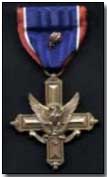Encyclopedia - Distinguished Service Cross (U.S.)
 The U.S. Distinguished
Service Cross medal was established on 2 January 1918 by U.S. President
Woodrow Wilson
(and supported by AEF Commander-in-Chief
John Pershing)
as a means of recognising particular individual acts of heroism within the
U.S. Army while under enemy fire during World War I (and which did not in
itself merit the higher Medal of Honor). It was stipulated that the
act of heroism involved be necessarily one deemed more than usually life
threatening.
The U.S. Distinguished
Service Cross medal was established on 2 January 1918 by U.S. President
Woodrow Wilson
(and supported by AEF Commander-in-Chief
John Pershing)
as a means of recognising particular individual acts of heroism within the
U.S. Army while under enemy fire during World War I (and which did not in
itself merit the higher Medal of Honor). It was stipulated that the
act of heroism involved be necessarily one deemed more than usually life
threatening.
The U.S. Congress formally instituted the medal on 9 July 1918. Two designs of the medal were issued (the photograph above is of the second), produced by the U.S. Mint at Philadelphia. The first issue - comprising just 100 medals - was subsequently modified and improved in attractiveness, although the initial medals were nonetheless awarded given the pressing need for the medal among the AEF (with replacements later issued once available).
The medal was two inches in height and 1 13/16 inches in width. An eagle featured on the centre of the medal's cross, with the text 'For Valor' written underneath. The reverse of the medal bore a circular wreath and the name of the recipient.
Recipients of the DSC (as it was known) who subsequently performed additional remarkable deeds of courage could be awarded an oak leaf cluster to be worn on the medal's ribbon.
A "blimp" was a word applied to an observation balloon.
- Did you know?
